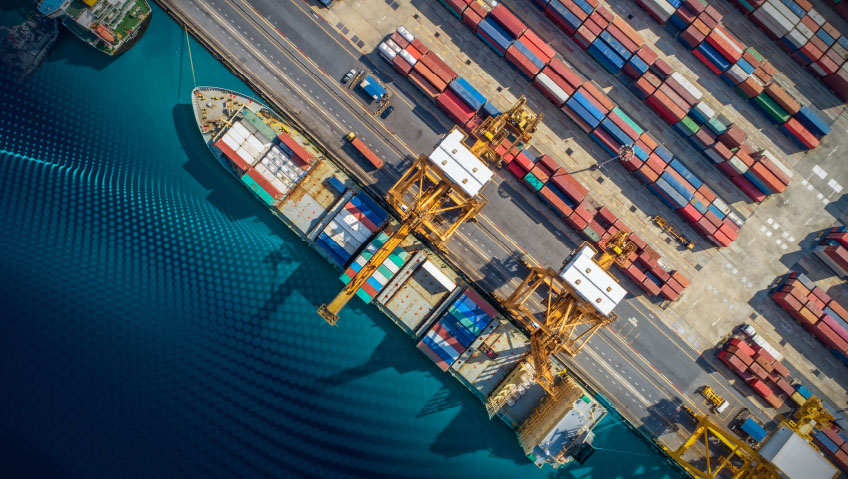“The Times They Are A-Changin’” wrote Bob Dylan in his classic song in the ‘60s. The intent and purpose of this song can be perceived as a lyrical message about the consistent need for change as world events and situations dictate. But perhaps more important is the inevitable response to change that determines the success or failure of a call to action.
The coronavirus pandemic has necessitated such a call to action for companies with respect to a crucial part of their performance; their lifeline – supply chains and supply chain management (SCM) and the accompanying critical component of a well managed, advanced logistics system.
The globalization of trade has many advantages, but also includes numerous supply chain risks for companies. Certainly the pandemic is not the sole antagonist for supply chain disruptions on an ever-evolving global trade stage. The availability and cost of raw materials can be affected by climate change or natural disasters. Global trade issues, new tariffs, labour disputes, and workforce shortages, for example, can also play a role in disruptions.
Such stressors force companies to take a closer look at just how fragile today’s supply chains can be and to acknowledge that a ‘redesign’ is required in these networks with a focus on competitive resilience. Resilience, adaptability and agility are major considerations in light of sudden, disruptive and unanticipated global events.
Companies are always striving to ensure that customer demands are being met; operations and adopted systems are efficient and sustainable. They strive to ensure business decisions are being made wisely with well informed research and data. Smart business leaders remain updated on the newest trends in supply chains and SCM.
Doing so enables the implementation of new strategies and business models that increase productivity and performance as well as provide the all important resiliency in a constantly shifting market. Better supply chains equate to better business.
Blockchain technology and transparent supply chains
Blockchain technology is an evolving technology in an ever expanding digital world. Many businesses today are concerned about the visibility of their supply chains, and this technology enables transparency. All of the elements involved, such as shipping lines, logistics providers, and carriers, among others, utilize the same platform for company and customer notification of a product’s journey from beginning to end point.
It is expected that close to $19 billion will be invested in Blockchain technology globally, by 2024, this according to the latest International Data Corporation (IDC) Worldwide Blockchain Spending Guide.
“This is an important time in the blockchain market as enterprises across markets and industries continue to increase their investment in technology,” noted James Wester, research director, Worldwide Blockchain Strategies. “The pandemic highlighted the need for more resilient, more transparent supply chains, healthcare delivery, financial services, and so much more, and enterprises around the world have been investing in blockchain to provide that resiliency and transparency.”
Elastic logistics – A flexible and agile business model
Supply chains need to be flexible and responsive to all fluctuations within a market. As current market demands can at times be unpredictable, elastic logistics, or on-demand logistics, is being implemented by more companies for its agility and flexibility to upscale or downscale in real-time, dependent on market fluctuations. Such technologies as AI aid supply chains by making adjustments when required with disruptions remaining as minimal as possible.
The goal of many companies is to improve operations while reducing costs and still remain competitive. Elastic Logistics provides a safety net during times of market fluctuations.
“ … Business is changing, and customer experience is more important than ever …. The winners in the ‘now economy’ may well be those who put customer experience first, use elastic logistics to adapt to fluctuations in consumer attitudes with ease,” stated Jan-Paul Boos, Senior Vice President Sales, BluJay Solutions, in Supply Chain Digital.
Internet of Things (IoT) – Connecting the world of commerce
IoT devices are increasing being implemented in logistics companies to enable supply chain transparency, which in turn will improve customer service and optimize a ROI. The trend of IoT utilization enhances the ability to efficiently transfer data, connect digitally and negates the need to manually collect data which runs the risk of human error.
Business intelligence software applications can be synchronized with the information generated by IoT which facilitates decisions about supply chain strategies based on data and real-time tracking, critical for temperature-sensitive goods, for example.
Combined with risk management strategies, a company’s digital network assists in building resilience especially when faced with disruptive events such as the corona virus pandemic.
Along with IoT, one can’t dismiss the growing roles played by Artificial Intelligence (AI), Augmented Reality (AR) Virtual Reality (VR) and robotic automation to create both realism and production enhancement to further advance product development.
The E-commerce logistics market
The entrance of the coronavirus onto the world stage has further spurred the world of e-commerce as consumers embraced a behavioral shift – constantly seeking those companies that can provide value-added services.
According to a Zion Market Research Report the “E-Commerce Logistics industry gathered revenue about US$ 72.6 billion during 2020 and is slated to earn revenue of approximately US$ 118.8 billion by 2028.”
E-commerce is “the fastest-growing Third-Party Logistics (3PL) Market segment,” notes Material Handling & Logistics [MH&L], continuing that “Retailers are increasingly relying upon Amazon and Third Party Logistics Providers to help manage omnichannel and e-commerce supply chain operations.”
To this, Transport Intelligence (TI) head of commercial development, Michael Clover indicates “E-commerce has been one of the key growth sectors for logistics over the course of the pandemic with the rise in demand creating opportunities for LSPs [Logistics Service Provider] and last-mile providers to grow rapidly, as long as they can help retailers react to the changes in consumer demands and manage wildly changing trading conditions”.
Referring back to the technology, elements of Blockchain and IoT will certainly aid in redefining E-commerce logistical growth by enabling secure and smart shipping.
Another key trend in the E-commerce logistics market is the emergence of Less Than Truckload Freight (LTL) Logistics. LTL shipping services are offered by numerous large, national parcel services and specialized logistics providers in the movement of smaller quantities or loads of freight especially by companies that require shipping of goods frequently. Doing so keeps the costs of individual shipments to be minimized.
The aforementioned are just some of the myriad of trends being seen in the manner in which supply chains and accompanying logistics are shaping the future by creating secure and robust services to meet the demands for cost efficiency, security and adaptability.
It’s not any easy task. It requires companies to redefine and take a more holistic analysis based on data and the testing of various scenarios that may ultimately lead to future sustainability of operations through a foundation of sound contingency plans.
The world is a-changin. That’s a certainty. As Benjamin Disraeli so simply summarized – “Change is inevitable. Change is constant.” Change is a motivator and progress would be impossible without it.













